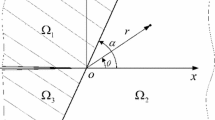Abstract
Bi-material interfaces are studied with cracks that end perpendicular to the interface. As is well-known, singularities in the stresses appear when classical elasticity is used. Moreover, the nature of the singularity depends on the difference in elastic constants of the two materials. In this paper, the gradient elasticity theory of Aifantis is used to remove these singularities. This is demonstrated for a range of ratios between the two Young’s moduli.
Similar content being viewed by others
References
Aifantis E.C. (1992) On the role of gradients in the localization of deformation and fracture. International Journal of Engineering Science 30: 1279–1299
Altan S.B., Aifantis E.C. (1992) On the structure of the mode III crack-tip in gradient elasticity. Scripta Metallurgica et Materialia 26: 319–324
Askes H., Aifantis E.C. (2002) Numerical modeling of size effect with gradient elasticity – formulation, meshless discretization and examples. International Journal of Fracture 117: 347–358
Askes H., Morata I., Aifantis E.C. (2008) Finite element analysis with staggered gradient elasticity. Computers & Structures 86: 1266–1279
Barut A., Guven I., Madenci E. (2001) Analysis of singular stress fields at junctions of multiple dissimilar materials under mechanical and thermal loading. International Journal of Solids and Structures 38: 9077–9109
Carpinteri A., Paggi M. (2007) Analytical study of the singularities arising at multi-material interfaces in 2D linear elastic problems. Engineering Fracture Mechanics 74: 59–74
Chang C.S., Gao J. (1995) Second-gradient constitutive theory for granular material with random packing structure. International Journal of Solids and Structures 32: 2279–2293
Erofeyev V.I. Wave processes in solids with microstructure. World Scientific (2003).
Fenner D.N. (1976) Stress singularities in composite materials with an arbitrarily oriented crack meeting an interface. International Journal of Fracture 12: 705–721
Gitman I.M., Askes H., Aifantis E.C. (2005) The Representative Volume size in static and dynamic micromacro transitions. International Journal of Fracture 135: L3–L9
Jakata K., Every A.G. (2008) Determination of the dispersive elastic constants of the cubic crystals Ge, Si, GaAs, and InSb. Phyical Review B 77: 174301
Kunin I.A. Elastic media with microstructure. I – One-dimensional models. Springer (1982).
Kunin I.A. Elastic media with microstructure. II – Three-dimensional models. Springer (1983).
Maranganti R., Sharma P. (2007) A novel atomistic approach to determine strain-gradient elasticity constants: Tabulation and comparison for various metals, semiconductors, silica, polymers and the (ir)relevance for nanotechnologies. Journal of the Mechanics and Physics of Solids 55: 1823–1852
Mindlin R.D. (1964), Micro-structure in linear elasiticity, Archive for Rational Mechanics and Analysis 16, 51-78
Műhlhaus H.-B., Oka F. (1996) Dispersion and wave propagation in discrete and continuous models for granular materials. International Journal of Solids and Structures 33: 2841–2858
Papanicolopulos S.-A., Zervos A., Vardoulakis I. (2009) A three dimensional C1 finite element for gradient elasticity. Internation Journal for Numerical Methods in Engineering 77: 1396–1415
Ru C.Q., Aifantis E.C. (1993) A simple approach to solve boundary-value problems in gradient elasticity. Acta Mechanica 101: 59–68
Suiker A.S.J., de Borst R., Chang C.S. (2001) Micro-mechanical modelling of granular material. Part 1: Derivation of a second–gradient micropolar constitutive theory Acta Mechanica 149 161180
Tang Z., Shen S., Atluri S.N. (2003) Analysis of materials with strain-gradient effects: a meshless local Petrov-Galerkin (MLPG) approach, with nodal displacements only. Computer Modeling in Engineering and Sciences 4: 177–196
Tenek L.T., Aifantis E.C. (2002) A two-dimensional finite element implementation of a special form of gradient elasticity. Computer Modeling in Engineering and Sciences 3: 731–741
Wang J., Karihaloo B.L. (1994) Mode II and mode III stress singularities and intensities at a crack tip terminating on a transversely isotropic-orthotropic bimaterial interface. Proceedings of the Royal Society A 444: 447–460
Zervos A. (2008) Finite elements for elasticity with microstructure and gradient elasticity. International Journal for Numerical Methods in Engineering 72: 564–595
Author information
Authors and Affiliations
Corresponding author
Rights and permissions
About this article
Cite this article
Askes, H., Gitman, I.M. Non-Singular Stresses in Gradient Elasticity at Bi-Material Interface with Transverse Crack. Int J Fract 156, 217–222 (2009). https://doi.org/10.1007/s10704-009-9357-0
Published:
Issue Date:
DOI: https://doi.org/10.1007/s10704-009-9357-0



